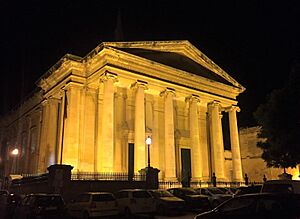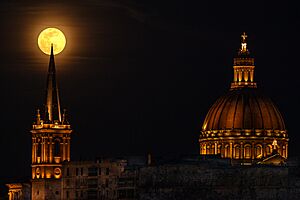St Paul's Pro-Cathedral, Valletta facts for kids
Quick facts for kids St Paul's Pro-Cathedral |
|
|---|---|
| The Pro-Cathedral and Collegiate Parish church of Saint Paul | |
|
Il-Pro-Katidral ta' San Pawl
|
|

St Paul's Pro-Cathedral, Valletta illuminated at night
|
|
| 35°54′1.2″N 14°30′41.5″E / 35.900333°N 14.511528°E | |
| Location | |
| Country | Malta |
| Denomination | Church of England |
| Churchmanship | High Church |
| Website | Cathedral Website |
| History | |
| Status | Pro-cathedral |
| Founded | 20 March 1839 |
| Founder(s) | Queen Adelaide |
| Dedication | St Paul |
| Dedicated | 1 November 1844 |
| Architecture | |
| Functional status | Active |
| Architect(s) | Richard Lankesheer (later adjustments by William Scamp) |
| Style | Neo-classical |
| Groundbreaking | 1839 |
| Completed | 1844 |
| Specifications | |
| Spire height | 200 ft (61 m) |
| Administration | |
| Archdeaconry | Italy and Malta |
| Diocese | Diocese in Europe |
| Province | |
St Paul's Pro-Cathedral (in Maltese: Il-Pro-Katridral ta' San Pawl) is an Anglican church in Valletta, Malta. It is called a "pro-cathedral" because it has the status of a cathedral, but it is not the main one. It is one of three cathedrals for the Anglican Diocese in Europe. You can find it in Independence Square.
Contents
Building a Special Church
The idea for this church came from Queen Adelaide. She visited Malta in the 1800s and noticed there was no proper place for Anglicans to worship. Before this, Anglican services were held in a room at the Grand Master's Palace.
The church was built where an old German Knights' building used to be. William Scamp designed it, and construction took place between 1839 and 1844. Queen Adelaide herself laid the first stone on March 20, 1839. You can still see her special banner hanging above the choir inside.
The first plans for the church were by Richard Lankasheer. However, the building was not stable, so William Scamp had to take over in 1841. He changed the plans to make the church strong and beautiful.
Surviving Through War
During World War II, the cathedral suffered some damage, and part of its roof fell in. But most of the building stayed standing. When repairs were made, some of Scamp's original ideas for the inside were finally built.
A special screen and choir area were added. A pulpit, which is a raised stand for speakers, was also built. It was dedicated to Sir Winston Churchill, a famous British leader. The east side of the church was turned into a baptistery, a place for baptisms.
The church also had an under-croft, which is like a basement. It was originally part of the old German Knights' building. In 1938, this under-croft was turned into a safe air-raid shelter. The church chaplain and many Maltese citizens used it for protection during the war. It was restored and improved in 2005.
Inside the Cathedral
This cathedral is a famous landmark in Valletta because of its tall spire. The spire rises over 60 metres (about 200 feet) into the sky. The church is built from Maltese limestone in a neo-classical style. This style uses ideas from ancient Greek and Roman buildings.
Inside, you'll see columns with fancy tops called Corinthian capitals. The six columns at the front entrance have Ionic capitals, which are a bit simpler. The main part of the building is about 33.5 metres long and 20.4 metres wide. Behind the main altar, there is a painting called Ecce Homo.
The Tall Steeple
The cathedral's steeple is very easy to spot, especially from the Marsamxett Harbour. It is an important part of Malta's cultural heritage.
In 2017, the church started a big project to restore the building and its steeple. They needed to raise €3,000,000 for the work. The restoration was finished in 2024. It even won an award in the XVIII DIN L-ART ĦELWA ARCHITECTURAL HERITAGE AWARDS.
The Historic Organ
Above the entrance to the cathedral, you'll find the organ. This organ originally came from Chester Cathedral in northwest England. It was built in 1684 by Bernard Smith.
There's a story that the famous composer George Frederick Handel played this organ. He supposedly played it in 1742 when he was on his way to Dublin for the first public performance of his famous work, "Messiah." He might have used it to practice some parts of the music. The organ has been changed and rebuilt many times over the years.
Connections to British Forces
The wooden panels around the main altar are a special memorial. They honor the Allied military groups that helped defend Malta between 1940 and 1943. Twelve flags hang in the aisles of the church. These flags represent groups like the Royal Air Force, the British Merchant Navy, and the Royal Navy.
Images for kids
See also
 In Spanish: Procatedral de San Pablo para niños
In Spanish: Procatedral de San Pablo para niños



